Curriculum Map
Click on our Curriculum Map to see what we are learning throughout the year!
Summer 2 Knowledge Organiser
Summer 2- What we are learning:
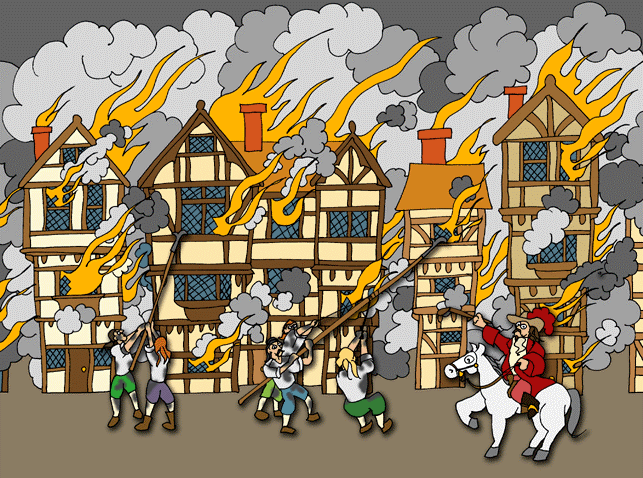
This half term our main theme is: London’s Burning
The main focus of this theme will be history and we will be learning about the events of the Great Fire of London. This theme will help us to develop an understanding of the ways in which we can find out about the past. We will also have the opportunity to increase our awareness of the past by learning about what London was like in the 17th century. We will be looking at comparing life in the 17th century to the present day and consider how some problems, such as the lack of an organised fire brigade, resources and types of buildings, cause the fire to spread. We will then focus on how and why some things have changed as a result of the fire.
 Mathematics
Mathematics
During Maths this term we will be learning how to tell the time. We will begin with some revision lessons, looking at telling the time to an hour and half hour. We will then move on to recognising time to 5 minutes and progress in a way that pupils will be able to tell the time, sequence it and manipulate and analogue clock. Pupils will then be learning how to find the duration of time, the end of a length of time, the beginning of a length of time and finally, compare lengths of time.
Following this unit of work, we will then revise over previously taught objects in order to consolidate our learning.
.jpg) English
English
During our English writing this term we will be concluding our Wind in the Willows topic by exploring classic poems. We will be learning to recite Ducks’ Ditty from Wind in the Willows by Kenneth Grahame using intonation. Through exploring this poem by the end of the unit we will have planned and written our own poem based on the model we have explored.
Our next writing topic is ‘buckets and spades’. In this unit of work we will be looking at a variety of seaside poems and identifying the different features during the reading phase. When writing we will be using these features and models to plan and write a seaside poem of our own. We will then finish the topic by looking at explanation texts. Our aim at the end of the topic is to write an explanation text linked to a process that happens at the seaside.
Our Phonics lessons will be based around Read Write Inc. We will also be doing discrete grammar and handwriting sessions each week.
.jpg) Religious Education
Religious Education
We will be continuing our unit of work that explores special places. We will be exploring places of worship across world faiths and will be investigating the following key questions:
- What makes a place special?
- What makes a place holy/sacred?
- Why do people of faith have special buildings where they gather to worship?
Please see our curriculum map and knowledge organiser to find out more…
Summer 1- What we are learning:
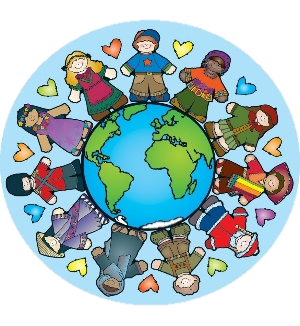
This half term our main theme is: No Place Like Home
We are continuing our Spring 2 theme of No Place Like Home. The main focus of this theme will be exploring the geography of the world and we will be improving our locational knowledge by locating the world’s seven continents and five oceans. We will also continue to improve our knowledge of human and physical features as we identify similarities and differences of a small area of the United Kingdom, and of a small area in a contrasting non-European country. We will then move on to exploring weather patterns and the location of hot and cold areas of the world in relation to the Equator and the North and South Poles.
 Mathematics
Mathematics
During Maths this term we will begin by learning about volume. We will learn how to compare volume, measure in litres and millilitres and solve word problems associated with volume.
The final unit of work in this half term will be learning how to tell the time. We will begin with some revision lessons, looking at telling the time to an hour and half hour. We will then move on to recognising time to 5 minutes and progress in a way that pupils will be able to tell the time, sequence it and manipulate and analogue clock. Pupils will then be learning how to find the duration of time, the end of a length of time, the beginning of a length of time and finally, compare lengths of time.
As Year 2 SATS are approaching we will also be revising over areas that have previously been taught as well as having weekly arithmetic lessons.
.jpg) English
English
Our English writing unit this half term is based on the story The Wind in the Willows. Through the reading stage there will be opportunities to use a range of talk and drama strategies to make inferences about characters and events using evidence from the text. We will also have opportunities to write about individual characters throughout this stage. During our writing phase we will be innovating the story and writing an adventure story based on The Wind in the Willows.
Our Phonics lessons will be based around Read Write Inc. We will also be doing discrete grammar and handwriting sessions each week.
 Science
Science
Our continuing science topic this half term is looking at plants. We will be exploring what plants need to stay healthy and will begin with carrying out our own investigations into what plants need to grow well. We will also closely observe the inside of a seed and learn about the life cycle of a plant. We will be able to identify how plants look when they don’t get the things they need and we will learn about how plants have adapted to live in different environments around the world.
.jpg) Religious Education
Religious Education
During our Easter Reflections week, we will be exploring our Easter unit ‘How do symbols help us to understand the Easter story?’. The aim of this unit is to give children an understanding that symbols are pictures or objects with a deeper meaning and a story to tell. Children will extend their knowledge of the details of the Easter story and develop their understanding of the importance of Easter and the concept of salvation.
We will be investigating the following key questions:
- How do symbols help us to understand the meaning of the Easter story?
- How does the meaning of (name a particular symbol) help us to understand the Easter story?
- Why is Easter the most important festival in the Christian calendar?
- What has saving people and rescue got to do with Jesus and Easter?
Following this, our next unit of work will be exploring ‘The Church’ and we will be asking the key question ‘Why is the church a special place for Christians?’ The aim of this unit is to give children an understanding of the church as a holy place and a body of people. This unit of work will also begin to give pupils an understanding of what happens in a church and why and additionally it will give opportunities to begin exploring places of worship across world faiths
We will be investigating the following key questions:
- What makes a place special? Where is your special place?
- What makes a place holy/sacred?
- What do you think makes a Church a special place?
- Why is the church a holy place for Christians?
- Why/when do people go to Church? What happens in the Church?
- Why do people of faith have special buildings where they gather to worship?
Please see our curriculum map and knowledge organiser to find out more…
Spring 2 Knowledge Organiser
Spring 2 What we are learning:
This half term our main theme is: No Place Like Home
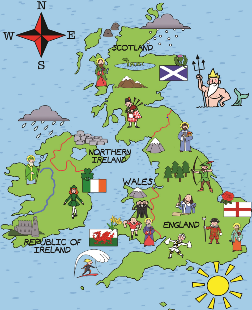
The main focus of this theme will be exploring the geography of the United Kingdom and we will be learning about the countries of the UK developing learning beyond the children’s immediate environment and own locality to the UK in general. We will explore the UK by looking at individual countries, capital cities and human and physical features. We will also be drawing on map skills and using simple compass direction to describe features and landmarks. Throughout this theme we will also explore the history of Skelmersdale were we will learn about what life was like in old town Sklemersdale during the mining years.
 Mathematics
Mathematics
During Maths this term we will begin by learning about 2D and 3D shapes where we will focus on identifying shapes based on their properties. When looking at shapes we will also identify how different patterns are made and how to describe a movement of a shape using directional vocabulary.
Our next unit of work will be looking at fractions. This is a challenging unit and it will provide pupils with a review of previously learn concepts which will extend pupils to find fractions of a whole number. We will begin by making equal parts- focusing on halves, quarters and thirds. Then we will learn to name fractions of the same denominations. We will then move on to comparing and ordering fractions.
The final unit of work in this half term will be learning how to tell the time. We will begin with some revision lessons, looking at telling the time to an hour and half hour. We will then move on to recognising time to 5 minutes and progress in a way that pupils will be able to tell the time, sequence it and manipulate and analogue clock. Pupils will then be learning how to find the duration of time, the end of a length of time, the beginning of a length of time and finally, compare lengths of time.
.jpg) English
English
Our English writing unit this half term is based on stories set on the farm. We will be immersed into several books which are set on farms in order to innovate our own narrative with a farm setting. Throughout the reading phase we will learn to make predictions and inferences based on what we can see and what we have read. We will also complete short writing tasks in response to the stories we have read. We will also focus on grammar objectives, in particular being able to identify the 4 sentence types- questions, statements, command and exclamations and adjectives which we can use to enhance our stories.
Our Phonics lessons will be based around Read Write Inc. We will also be doing discrete handwriting sessions each week.
 Science
Science
Our science topic this half term is looking at plants. We will be exploring what plants need to stay healthy and will begin with carrying out our own investigations into what plants need to grow well. We will also closely observe the inside of a seed and learn about the life cycle of a plant. We will be able to identify how plants look when they don’t get the things they need and we will learn about how plants have adapted to live in different environments around the world.
.jpg) Religious Education
Religious Education
For the first part of this half term, we are continuing to explore the RE unit ‘Jesus a friend to everyone’ and our leading question is- Why did Jesus welcome everyone? The aim of this unit is to increase our awareness that Jesus was an extraordinary person who welcomed everyone as a friend and to develop our knowledge and understanding that Jesus had the power to miraculously heal people.
We will be investigating the following key questions:
- What is a miracle?
- Why are these stories important?
- Why did Jesus welcome everyone?
- I wonder how it felt to meet Jesus?
- What did Jesus want us to learn from his behaviour?
- What do these stories reveal about Jesus?
During the end of this half term we will be leading up to Easter and will be exploring our Easter unit ‘How do symbols help us to understand the Easter story?’. The aim of this unit is to give children an understanding that symbols are pictures or objects with a deeper meaning and a story to tell. Children will extend their knowledge of the details of the Easter story and develop their understanding of the importance of Easter and the concept of salvation.
We will be investigating the following key questions:
- How do symbols help us to understand the meaning of the Easter story?
- How does the meaning of (name a particular symbol) help us to understand the Easter story?
- Why is Easter the most important festival in the Christian calendar?
- What has saving people and rescue got to do with Jesus and Easter?
Please see our curriculum map and knowledge organiser to find out more…
Spring 1 Knowledge Organiser
Spring 1 What we are learning:
This half term our main theme is: Standing in the hall of fame!
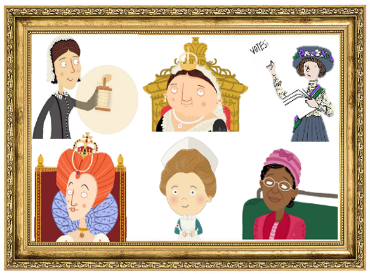
The main focus of this theme will be History and we will be learning about the lives of a number of significant individuals in the past who have contributed to national and international achievements as well as comparing aspects of life in different periods. We will be exploring the significance of Elizabeth I and Queen Victoria, Rosa Parks and Emily Davison and finally; Mary Seacole, Florence Nightingale and Edith Cavell.
 Mathematics
Mathematics
During Maths this term we will begin by learning about mass in the context of kilograms and grams. We will learn how to read a scale, to compare the weight of different objects and to solve word problems relating to mass. Moving swiftly on, we will then be exploring temperature. We will be learning about Celsius, how to read thermometers and we will look at the different kinds of temperatures we can measure.
During our third week of this half term we will be looking at interpreting pictograms. We will learn how to read, interpret, analyse and construct our own picture graphs with confidence.
Finally, we will end this half term by looking at money. We will be revising the different coins and notes and looking at how we can represent an amount using £ and p. We will look at how we can make different combinations of monetary values as well as how to calculate the cost of several items and give change.
.jpg) English
English
Our English and Phonics lessons will be based around Read Write Inc. We will also be doing discrete grammar and handwriting sessions each week.
 Science
Science
Our science topic this half term is looking at materials and in particular, the everyday uses of materials. We will be exploring properties of materials such as wood, plastic, metial, glass, brick, paper and cardboard. We will be going on to compare the suitability of different everyday materials for different purposes. We will also be exploring how objects made of some everyday materials can change shape and how the recycling process is able to reuse some everyday materials numerous times.
.jpg) Religious Education
Religious Education
Our RE unit this half term is ‘Jesus a friend to everyone’ and our leading question is- Why did Jesus welcome everyone? The aim of this unit is to increase our awareness that Jesus was an extraordinary person who welcomed everyone as a friend and to develop our knowledge and understanding that Jesus had the power to miraculously heal people.
We will be investigating the following key questions:
- What is a miracle?
- Why are these stories important?
- Why did Jesus welcome everyone?
- I wonder how it felt to meet Jesus?
- What did Jesus want us to learn from his behaviour?
- What do these stories reveal about Jesus?
Autumn 2 Knowledge Organiser
Autumn 2 What we are learning:
This half term our main theme is: Remember, Remember…
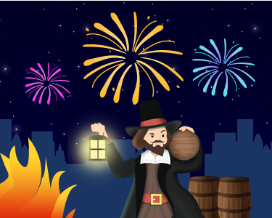
The main focus of this theme will be History and we will be learning all about the infamous gunpowder plot. In this unit of work, we will be developing our knowledge and understanding of this significant event in British history. We will be increasing our awareness of the past by exploring key questions such as; who was Guy Fawkes? We will also explore other significant individuals who were involved in the plot such as Robert Catesby and Thomas Percy. We will also be deepening our understanding of the events of the Gunpowder plot through several speaking and listening activities, such as hot seating and role play, as well as sequencing events and designing posters. We will also link in a lesson on how bonfire night has been celebrated in Britain since the 1930’s so that we can consolidate our knowledge of changes within living memory.
We also have an additional ‘mini theme’ at the end of this half term:
‘Christmas is Coming!’

During this theme we will be looking at the nativity story in preparation for our KS1 carol performance. We will also be linking our RE unit- Christmas –Why was the birth of Jesus such good news? to our theme and we will be completing lots of Christmas related activities including; making Christmas tree decorations, designing Christmas cards and calendars and many more Christmas related crafts!
 Mathematics
Mathematics
During Maths this term we will be continuing our learning of multiplication and division. We will begin by looking at different ways of sharing, including sharing and grouping before covering division by 2, 5 and 10. We will also investigate links between multiplication and division and odd and even numbers.
We will then be moving on to look at measurements. In this unit of work, we will gain a better understanding of how to measure length. We will begin by understanding what a metre is and what centimetres are and then progress to using them in real-life contexts. Following this we will be learning about mass in the context of kilograms and grams. We will learn how to read a scale, to compare the weight of different objects and to solve word problems relating to mass. Finally, we will end the term by exploring temperature. We will be learning about Celsius, how to read thermometers to help and we will look at the different kinds of temperatures we can measure.
.jpg) English
English
Our English and Phonics lessons will be based around Read Write Inc. We will also be doing discrete grammar and handwriting sessions each week.
.jpg) Religious Education
Religious Education
At the beginning of this half term, we are continuing our unit of work on ‘The Bible: Why is it such a special book?’. We are going to finish this unit of work by widening our understanding of holy books from faiths other than Christianity and explore their significance in the lives of believers.
We will then move on to beginning the RE unit ‘Christmas- Why was the birth of Jesus such good news? The aim of this unit is to look at the story of Christmas from the perspective that it was good news then and now. We will be investigating the following key questions:
- How is good news delivered?
- Who passes on good news?
- Why was the birth of Jesus good news?
- Why is this news so important?
- What difference did it make to the world?
- How did the good news spread further?
- How is this good news told today?
- How is this good news celebrated today?
- The news is very old, how can it still be good news?
- What do angels do?
- What do angels look like?
Please see our curriculum map and knowledge organiser to find out more…
Autumn 1 Knowledge Organiser
Autumn 1 What we are learning:
This half term our main theme is: Whooo lives in a place like this?

The main focus of this theme will be Science and we will be learning all about living things and their habitats. We will be learning about a variety of habitats and the plants and animals that live there. We will learn to tell the difference between things that are living, dead and things that have never been alive, applying this in a range of contexts. We will also make observations of a local habitat and the creatures that live there, investigating conditions in local microhabitats and how they affect the minibeasts found within them. We will research a range of global habitats and learn about how the living things that live there are suited to their environments and depend on their surroundings to keep them alive. This theme will also incorporate other areas of the curriculum such as Art and Design and Design Technology.
We also have a ‘mini theme’ this half-term:

‘Our School Values Week’ in which we will be gaining a deeper understanding of The Big Freize and exploring the importance of our school values. Throughout the week we will have a clearer idea of what Emma Yarlett’s Big Freize depicts and how this links to God’s Big Story. We will then explore our school and Christian values through stories found in the Bible and identify which panel the story belongs to.
 Mathematics
Mathematics
During Maths this term we will be beginning our unit of work by focusing on various aspects of numbers to 100. By the end of the unit we will be able to count to 100 through different steps, including counting up in tens, fives and twos. Place value will have a major role throughout the chapter. We will also look at comparing numbers using our place-value knowledge Our final two lessons will allow us an opportunity to explore numbers to see patterns within 100.
In our next unit of work for this half term, we will be exploring addition and subtraction, using number bond diagrams as well as the standard column method. We will be taken through each lesson with slight variations in the learning objects so that we can reach a level of mastery.
Our final unit of work investigates the multiplication of 2, 5 and 10. We will also have the opportunity to understand what multiplication means and what it looks like. Patterns in multiplication and commutative law are also covered in this chapter.
.jpg) English
English
Our English and Phonics lessons will be based around Read Write Inc. We will also be doing discrete grammar and handwriting sessions each week.
.jpg) Religious Education
Religious Education
Our RE top this term is ‘The Bible: Why is it such a special book?’ During this topic, we will widen our understanding of the Bible, its contents, presentation and importance to Christians. We will be investigating the following key questions:
- Why is the Bible special?
- Why does the vicar/minister think that the Bible is special?
- Which Bible stories do you enjoy? Why?
- Who uses the Bible? Why?
- The Bible is in two parts which are different. Why/how are they different?
Finally we will end our unit of work by beginning to investigate our understanding of holy books from faiths other than Christianity and explore their significance in the lives of believers.
Please see our curriculum map and knowledge organiser to find out more…
.png)